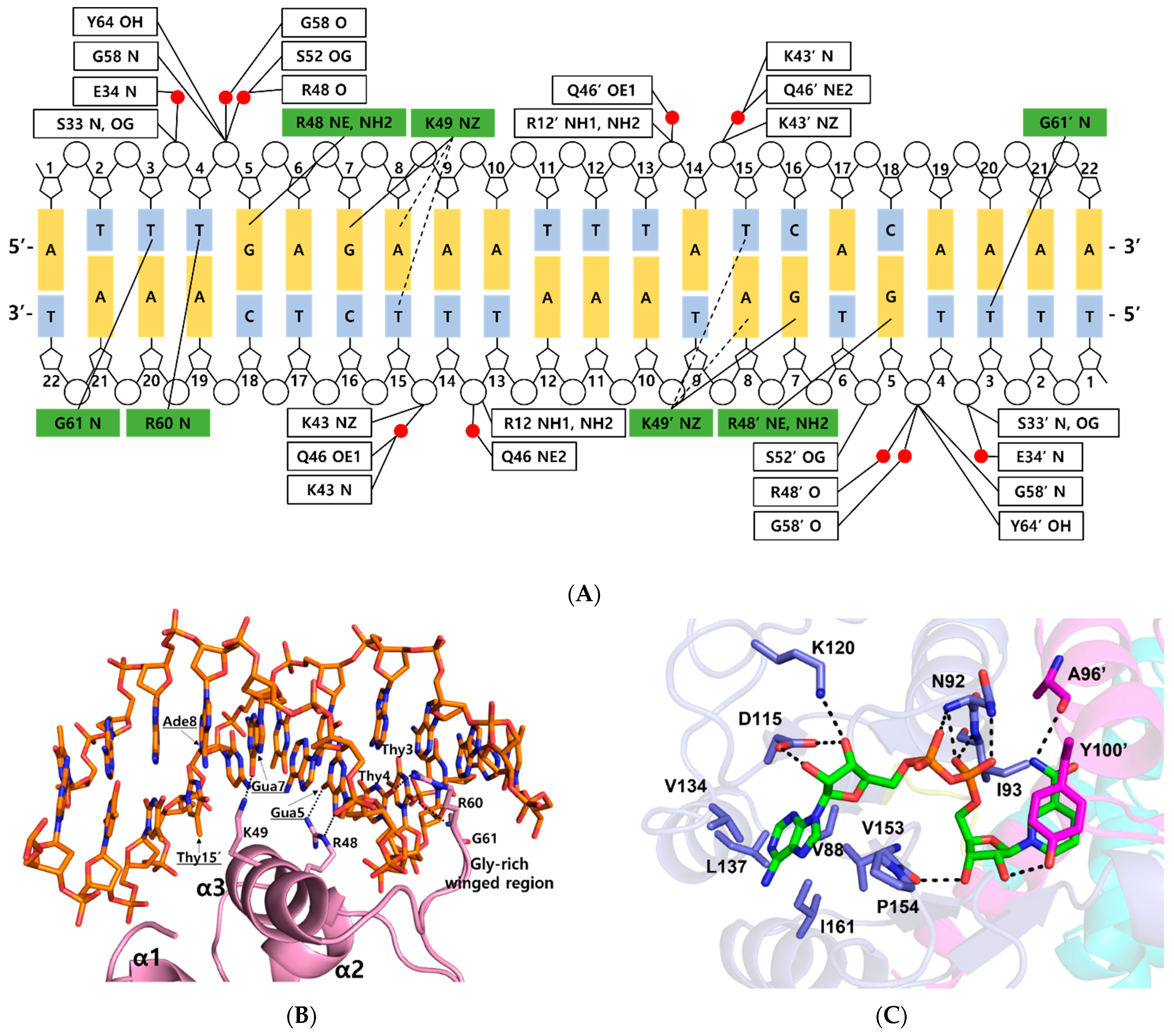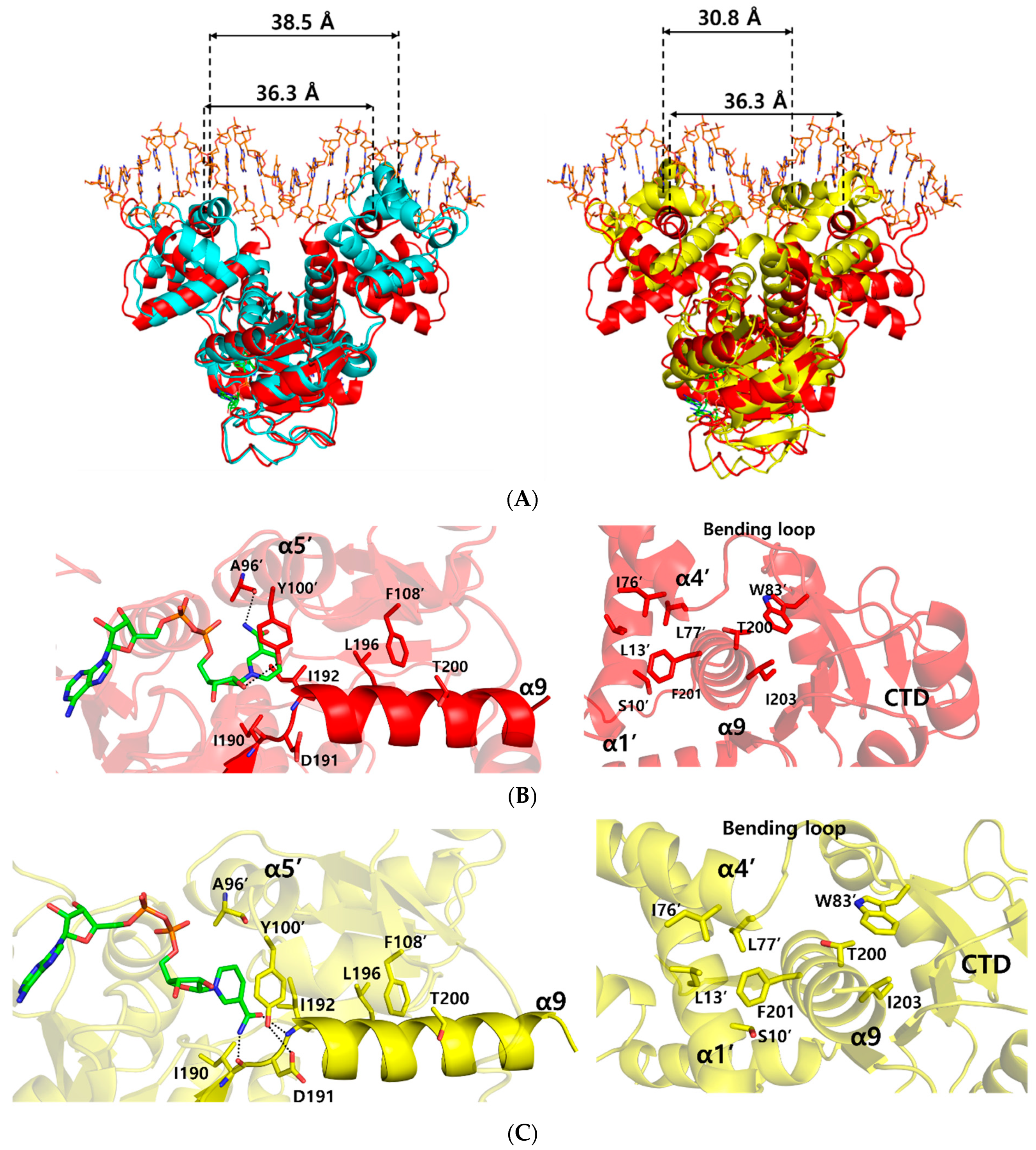Structural Basis of Redox-Sensing Transcriptional Repressor Rex with Cofactor NAD+ and Operator DNA
Abstract
:1. Introduction
2. Results and Discussion
2.1. Model Building and Quality
2.2. Ternary Complex of the T. maritima Rex
2.3. NAD+ Binding Site
2.4. Conformational Changes on DNA Binding
3. Materials and Methods
3.1. Sample Preparation and Crystallization
3.2. Data Collection
3.3. Structure Determination and Refinement
3.4. Data Deposition
4. Conclusions
Supplementary Materials
Author Contributions
Funding
Institutional Review Board Statement
Informed Consent Statement
Data Availability Statement
Acknowledgments
Conflicts of Interest
References
- Green, J.; Paget, M.S. Bacterial redox sensors. Nat. Rev. Microbiol. 2004, 2, 954–966. [Google Scholar] [CrossRef] [PubMed]
- Liu, X.; Cheng, Y.; Lyu, M.; Wen, Y.; Song, Y.; Chen, Z.; Li, J. Redox-sensing regulator Rex regulates aerobic metabolism, morphological differentiation, and avermectin production in Streptomyces avermitilis. Sci. Rep. 2017, 7, 44567. [Google Scholar] [CrossRef] [PubMed] [Green Version]
- Belenky, P.; Bogan, K.L.; Brenner, C. NAD+ metabolism in health and disease. Trends Biochem. Sci. 2007, 32, 12–19. [Google Scholar] [CrossRef] [PubMed]
- Xiao, W.; Wang, R.S.; Handy, D.E.; Loscalzo, J. NAD(H) and NADP(H) Redox Couples and Cellular Energy Metabolism. Antioxid. Redox Signal. 2018, 28, 251–272. [Google Scholar] [CrossRef] [PubMed]
- Brekasis, D.; Paget, M.S. A novel sensor of NADH/NAD+ redox poise in Streptomyces coelicolor A3(2). EMBO J. 2003, 22, 4856–4865. [Google Scholar] [CrossRef] [PubMed]
- Fernie, A.R.; Carrari, F.; Sweetlove, L.J. Respiratory metabolism: Glycolysis, the TCA cycle and mitochondrial electron transport. Curr. Opin. Plant Biol. 2004, 7, 254–261. [Google Scholar] [CrossRef]
- Hu, L.; Huang, H.; Yuan, H.; Tao, F.; Xie, H.; Wang, S. Rex in Clostridium kluyveri is a global redox-sensing transcriptional regulator. J. Biotechnol. 2016, 233, 17–25. [Google Scholar] [CrossRef]
- Larsson, J.T.; Rogstam, A.; von Wachenfeldt, C. Coordinated patterns of cytochrome bd and lactate dehydrogenase expression in Bacillus subtilis. Microbiology 2005, 151, 3323–3335. [Google Scholar] [CrossRef] [Green Version]
- Bitoun, J.P.; Nguyen, A.H.; Fan, Y.; Burne, R.A.; Wen, Z.T. Transcriptional repressor Rex is involved in regulation of oxidative stress response and biofilm formation by Streptococcus mutans. FEMS Microbiol. Lett. 2011, 320, 110–117. [Google Scholar] [CrossRef]
- Bitoun, J.P.; Liao, S.; Yao, X.; Xie, G.G.; Wen, Z.T. The redox-sensing regulator Rex modulates central carbon metabolism, stress tolerance response and biofilm formation by Streptococcus mutans. PLoS ONE 2012, 7, e44766. [Google Scholar] [CrossRef]
- Pagels, M.; Fuchs, S.; Pane-Farre, J.; Kohler, C.; Menschner, L.; Hecker, M.; McNamarra, P.J.; Bauer, M.C.; von Wachenfeldt, C.; Liebeke, M.; et al. Redox sensing by a Rex-family repressor is involved in the regulation of anaerobic gene expression in Staphylococcus aureus. Mol. Microbiol. 2010, 76, 1142–1161. [Google Scholar] [CrossRef] [PubMed] [Green Version]
- Vesic, D.; Kristich, C.J. A Rex family transcriptional repressor influences H2O2 accumulation by Enterococcus faecalis. J. Bacteriol. 2013, 195, 1815–1824. [Google Scholar] [CrossRef] [PubMed] [Green Version]
- Bitoun, J.P.; Wen, Z.T. Transcription factor Rex in regulation of pathophysiology in oral pathogens. Mol. Oral Microbiol. 2016, 31, 115–124. [Google Scholar] [CrossRef] [Green Version]
- Zhu, H.; Wang, Y.; Ni, Y.; Zhou, J.; Han, L.; Yu, Z.; Mao, A.; Wang, D.; Fan, H.; He, K. The Redox-Sensing Regulator Rex Contributes to the Virulence and Oxidative Stress Response of Streptococcus suis Serotype 2. Front. Cell. Infect. Microbiol. 2018, 8, 317. [Google Scholar] [CrossRef] [Green Version]
- Ravcheev, D.A.; Li, X.; Latif, H.; Zengler, K.; Leyn, S.A.; Korostelev, Y.D.; Kazakov, A.E.; Novichkov, P.S.; Osterman, A.L.; Rodionov, D.A. Transcriptional regulation of central carbon and energy metabolism in bacteria by redox-responsive repressor Rex. J. Bacteriol. 2012, 194, 1145–1157. [Google Scholar] [CrossRef] [PubMed]
- McLaughlin, K.J.; Strain-Damerell, C.M.; Xie, K.; Brekasis, D.; Soares, A.S.; Paget, M.S.; Kielkopf, C.L. Structural basis for NADH/NAD+ redox sensing by a Rex family repressor. Mol. Cell 2010, 38, 563–575. [Google Scholar] [CrossRef] [PubMed]
- Zheng, Y.; Ko, T.P.; Sun, H.; Huang, C.H.; Pei, J.; Qiu, R.; Wang, A.H.; Wiegel, J.; Shao, W.; Guo, R.T. Distinct structural features of Rex-family repressors to sense redox levels in anaerobes and aerobes. J. Struct. Biol. 2014, 188, 195–204. [Google Scholar] [CrossRef] [Green Version]
- Franza, T.; Rogstam, A.; Thiyagarajan, S.; Sullivan, M.J.; Derre-Bobillot, A.; Bauer, M.C.; Goh, K.G.K.; Da Cunha, V.; Glaser, P.; Logan, D.T.; et al. NAD+ pool depletion as a signal for the Rex regulon involved in Streptococcus agalactiae virulence. PLoS Pathog. 2021, 17, e1009791. [Google Scholar] [CrossRef]
- Sickmier, E.A.; Brekasis, D.; Paranawithana, S.; Bonanno, J.B.; Paget, M.S.; Burley, S.K.; Kielkopf, C.L. X-ray structure of a Rex-family repressor/NADH complex insights into the mechanism of redox sensing. Structure 2005, 13, 43–54. [Google Scholar] [CrossRef] [Green Version]
- Wang, E.; Bauer, M.C.; Rogstam, A.; Linse, S.; Logan, D.T.; von Wachenfeldt, C. Structure and functional properties of the Bacillus subtilis transcriptional repressor Rex. Mol. Microbiol. 2008, 69, 466–478. [Google Scholar] [CrossRef]
- Park, Y.W.; Jang, Y.Y.; Joo, H.K.; Lee, J.Y. Structural Analysis of Redox-sensing Transcriptional Repressor Rex from Thermotoga maritima. Sci. Rep. 2018, 8, 13244. [Google Scholar] [CrossRef] [PubMed]
- Holm, L.; Laakso, L.M. Dali server update. Nucleic Acids Res. 2016, 44, W351–W355. [Google Scholar] [CrossRef] [PubMed]
- Kabsch, W. Xds. Acta Crystallogr. D Biol. Crystallogr. 2010, 66, 125–132. [Google Scholar] [CrossRef] [PubMed] [Green Version]
- Collaborative Computational Project Number 4. The CCP4 suite: Programs for protein crystallography. Acta Crystallogr. D Biol. Crystallogr. 1994, 50, 760–763. [Google Scholar] [CrossRef]
- Mccoy, A.J.; Grosse-Kunstleve, R.W.; Adams, P.D.; Winn, M.D.; Storoni, L.C.; Read, R.J. Phaser crystallographic software. J. Appl. Crystallogr. 2007, 40, 658–674. [Google Scholar] [CrossRef] [PubMed] [Green Version]
- Emsley, P.; Cowtan, K. Coot: Model-building tools for molecular graphics. Acta Crystallogr. D Biol. Crystallogr. 2004, 60, 2126–2132. [Google Scholar] [CrossRef] [Green Version]
- Afonine, P.V.; Grosse-Kunstleve, R.W.; Echols, N.; Headd, J.J.; Moriarty, N.W.; Mustyakimov, M.; Terwilliger, T.C.; Urzhumtsev, A.; Zwart, P.H.; Adams, P.D. Towards automated crystallographic structure refinement with phenix.refine. Acta Crystallogr. D Biol. Crystallogr. 2012, 68, 352–367. [Google Scholar] [CrossRef] [PubMed] [Green Version]
- Williams, C.J.; Headd, J.J.; Moriarty, N.W.; Prisant, M.G.; Videau, L.L.; Deis, L.N.; Verma, V.; Keedy, D.A.; Hintze, B.J.; Chen, V.B.; et al. MolProbity: More and better reference data for improved all-atom structure validation. Protein Sci. 2018, 27, 293–315. [Google Scholar] [CrossRef] [PubMed]




| Data Set | Ternary Complex of Tma Rex |
|---|---|
| Data Collection Statistics | |
| Space group | P21 |
| Unit-cell parameters | |
| a, b, c (Å) | 69.14, 62.84, 68.94 |
| α, β, γ (°) | 90.00, 108.71, 90.00 |
| Wavelength (Å) | 0.999994 |
| Resolution (Å) | 50.00–2.40 (2.53–2.40) a |
| Number of observations | 84,920 |
| Unique reflections | 22,008 |
| Data completeness (%) | 99.7 (98.1) a |
| Redundancy | 3.9 (3.9) a |
| Average I/σ(I) | 5.5 (2.1) a |
| Rmerge (%) ab | 13.9 (44.0) a |
| Refinement statistics | |
| Resolution (Å) | 45.34–2.40 |
| Rwork/Rfree (%) | 19.53/25.09 |
| No. of non-H atoms | 4233 |
| Protein | 3158 |
| DNA | 896 |
| Ligand (NAD+) | 88 |
| Water | 91 |
| Root-mean square deviations | |
| bonds (Å) | 0.002 |
| angles (°) | 0.442 |
| Average B-factor (Å2) | 45.00 |
| Protein | 39.24 |
| DNA | 66.58 |
| Ligand (NAD+) | 36.89 |
| Water | 40.42 |
| Ramachandran plot (%) | |
| Favored | 98.01 |
| Allowed | 1.99 |
| Outliers | 0 |
Publisher’s Note: MDPI stays neutral with regard to jurisdictional claims in published maps and institutional affiliations. |
© 2022 by the authors. Licensee MDPI, Basel, Switzerland. This article is an open access article distributed under the terms and conditions of the Creative Commons Attribution (CC BY) license (https://creativecommons.org/licenses/by/4.0/).
Share and Cite
Jeong, K.H.; Lee, H.J.; Park, Y.W.; Lee, J.Y. Structural Basis of Redox-Sensing Transcriptional Repressor Rex with Cofactor NAD+ and Operator DNA. Int. J. Mol. Sci. 2022, 23, 1578. https://doi.org/10.3390/ijms23031578
Jeong KH, Lee HJ, Park YW, Lee JY. Structural Basis of Redox-Sensing Transcriptional Repressor Rex with Cofactor NAD+ and Operator DNA. International Journal of Molecular Sciences. 2022; 23(3):1578. https://doi.org/10.3390/ijms23031578
Chicago/Turabian StyleJeong, Kang Hwa, Hyun Jin Lee, Young Woo Park, and Jae Young Lee. 2022. "Structural Basis of Redox-Sensing Transcriptional Repressor Rex with Cofactor NAD+ and Operator DNA" International Journal of Molecular Sciences 23, no. 3: 1578. https://doi.org/10.3390/ijms23031578





